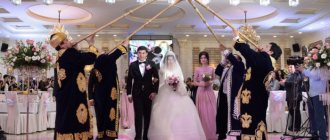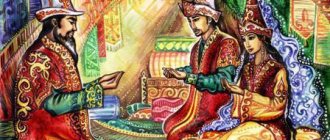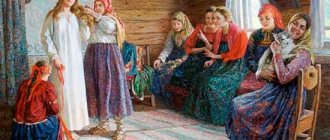The Republic of Dagestan is the most multinational region of the Russian Federation. In the “country of mountains”, more than a hundred nationalities live in close proximity. Each of these ethnic communities brought their own traditional values, gradually giving birth to that peculiar way of life that can be observed to this day. From village to village, customs change, remaining largely similar. Dagestanis revere traditions, preserving all the richness of folk culture in our age of change. A Dagestan wedding these days means unique age-old traditions, hospitality and a unique national flavor, adapted to modern realities.
Features of the culture of the Dagestan people
Dagestan has very strong traditions of hospitality. A set of rules that has existed for centuries prescribes hosts to be kind and attentive to guests. The homes of Dagestanis are always open to dear relatives, neighbors, and friends. Even a stranger who accidentally finds himself in the village is accepted as his own relative.
Children and youth are taught to listen to and honor their elders, respect their parents and protect their clan and family.
Despite the influence of Islam, adopted by the inhabitants of Dagestan since the rule of the Turks and Persians, women here have a special, caring attitude. Some researchers believe that initially matriarchy reigned in local tribes. The emphatically respectful, even naming in the third person, attitude of the wife towards her husband is adjacent to the prohibition for the weaker sex to engage in heavy physical labor. The polite wisdom of women can always cool the hot heads of male arguers. Also, in Dagestan it was not customary to wear a veil; on the contrary, girls and women dressed brightly, with numerous head decorations.
A wedding in Dagestan is not just a union of two loving hearts, it is an occasion for all relatives and friends to gather for a celebration of stunning scope. During this period, two separate families merge into a single whole. New relatives actively get to know each other and communicate. In the old days, local villages lived from wedding to wedding. All the surrounding villages gathered for this significant event, and guests came from remote areas. The wedding was celebrated in several stages, and the preparatory period began with the birth of children.
First day
As a rule, Dagestan marriages are very strong and last a lifetime. To a greater extent, this is due to the expressed religiosity of the people, since only the imam can break off a marriage, and he needs good reasons for this. Therefore, Dagestan weddings are always fun and noisy, because they are played only once. The entire community attends these weddings, and the number of guests can reach thousands.
Before the first wedding day, all relatives are actively preparing, performing previously agreed upon duties. The parents of the young people honor their deceased relatives and perform a sacrificial offering in honor of the young ones. Musicians are also invited in advance. Most often they are called from other villages, and all the way to the house where the holiday will take place, they must sing, announcing the place of the celebration.
Traditions of celebrating the first wedding day in Dagestan begin with ritual music. Musicians gather on the roof of the house, playing ritual songs that are distinguished by their prayerful power. At noon, the wedding procession leaves the groom's house. It consists of young relatives, mostly female. On the way to the bride's home, they sing songs, dance and carry gifts and trays of sweets. The gifts consisted of a pair of breads, halva, a bag of tobacco, needles, threads and other things. Participants in the wedding procession entered the bride's house and placed gifts in a chest. The newlywed will subsequently take him with her to her husband’s house.
The wedding ceremony of the Dagestanis consists of a tradition when the newlyweds are sent to the house of their closest relatives, for example, a sister or brother. That's why they don't meet on the first day. It was considered positive for the bride and groom to be among a large crowd of people before the wedding.
Meanwhile, guests arrive from different parts of the country and gather near the house. They announce their visit with music, songs or gun shots.
On this day, the bride is prepared to be handed over to the groom. The mother collects a dowry for her and a farewell ceremony is held, with ritual songs and crying.
Acquaintance and conspiracy
In the old days, it was customary to persuade children from the cradle. And this is not a whim: with the restrictions that wedding traditions imposed, it was quite difficult to find a suitable couple in the region. Basically, this custom flourished among wealthy families. The father of the young groom gave a valuable thing as collateral, and the children were considered to be in agreement.
The most common was collusion between boys and girls in adolescence and adulthood. Senior relatives and parents were looking for the bride, including all their friends and neighbors. The girl had to demonstrate certain qualities: hard work, restraint of emotions, knowledge of etiquette. Physical health, the absence of deformities and mental illness among relatives, the origin and well-being of the family were also important. Before the wedding, the young couple may not have known each other at all.
In modern Dagestan, young people have the opportunity to make acquaintances on their own. But even now, boys and girls listen to the opinions of older relatives, and marriage without the blessing of their parents is unthinkable.
Another traditional way to get married was bride kidnapping. This move made it possible to avoid the huge costs of ransom and wedding arrangements, as well as to marry against the will of the chosen girl’s relatives. As a rule, refusal followed if the applicant for the daughter’s hand in marriage was lower on the social ladder, from an impoverished family, or from a family with which there was enmity. A girl who spent the night under the roof of a stranger was considered disgraced. If she managed to escape before dawn, then it was believed that the girl managed to defend her honor. If not, the relatives had no choice but to agree to an immediate wedding. However, enraged relatives could declare blood feud for the shame of their daughter and sister, which did not ease the fate of the unfortunate woman, who was losing hope of a worthy match. Bride kidnapping these days is prosecuted by law, and usually occurs by mutual consent, as a beautiful, stylized antique ritual.
Preparation period
Since divorces are extremely rare in Dagestan, the choice of a soul mate is approached with all responsibility. As soon as the young man or his family decides on the candidacy of the future bride, at the family council they carefully evaluate the girl, her behavior and reputation, look at the well-being of the family, and make inquiries about her relatives. If everything suits you, they send matchmakers to the chosen one’s parents – the groom’s parents, older relatives or friends. The Avars, on the contrary, invite the girl’s father to the house. The matter is not limited to one visit: a decent girl cannot give an answer immediately, and there are also frequent cases of refusal when the groom does not suit the girl’s relatives or herself.
As soon as the issue is resolved positively, the groom’s mother puts rings and a bracelet on the bride’s hands, after which the girl is considered to have agreed. Next comes the betrothal ceremony.
Betrothal in Dagestan
The groom, accompanied by relatives, arrives at the girl’s house with gifts. Previously, there was a custom when these gifts, along with the girl’s dowry, were hung on ropes for everyone to see; in some villages it is still preserved, so it is not customary to skimp. On this day, not only engagement occurs. The parties agree on the amount of the dowry, bride price and kalym. Also, wedding days are set.
A characteristic feature of a wedding in Dagestan is the holding of two celebrations with an interval of a week. This custom is easy to explain: in the old days, with the adoption of Muslim customs, wedding feasts were held separately for men and women. Moreover, parents could not accompany their daughter and attend a feast at the house of the groom's parents. And I wanted to attend the wedding of my own blood. So they held separate feasts. At the appointed moment, the groom and his friends arrived at the “women’s” wedding and took the bride, accompanied by her unmarried sisters, to a new family life. Having lost its original meaning, the tradition has survived, undergoing changes. Now there are two weddings, each time gathering all the guests.
Dowry and bride price
Money for bride price and dowry begins to be collected from the birth of a child. Household supplies, fabrics, and decorations are also prepared for the girl. For the young man's wedding, parents must provide a luxurious feast and separate housing, gifts and money to buy the chosen one. The amount of ransom and dowry is not established: in each specific case, the parties agree according to their position in society and wealth. At the same time, it is not customary to demonstrate stinginess and greed.
Traditional outfits of young people
Modern newlyweds prefer the classics - white dresses, suits, or traditional vestments in folk style. Often brides appear in both versions, fortunately, a double celebration allows this. The requirements for the bride's outfit are quite strict. The dress should be long, elegant, emphasizing the grace and beauty of the girl. The fabric is chosen expensive, decorations are selected. Veils and bedspreads are not accepted in Dagestan.
For young men who want to pay tribute to traditional dances, a second, national outfit with a mandatory furry hat is also required. It is in this vestment that he will lead his chosen one in the fiery dance of the newlyweds.
How does matchmaking and engagement work?
In Dagestan, the word of parents still means a lot to children. Therefore, a mandatory pre-wedding stage is sending matchmakers. There are 2 traditions in this area:
- Matchmaking with engagement occurs when children are still small, but gradually this method began to lose popularity among the population. Previously, it made it possible to know for sure that a child would be able to create a family that would produce healthy offspring. This was especially important for small villages, because often such engagements were concluded between representatives of different localities. Now, with the increase in the number and greater mobility of people, there is no danger of being left without grandchildren.
- Adult matchmaking. Moreover, most often it is organized after the groom expressed such a desire to his parents on the first day. If they approve of the girl, then matchmakers are sent to her house.
Unlike a Dagestan wedding, matchmaking is a closed procedure, one might even say secret. The matchmakers come to the marriageable girl's house in the evening, making efforts to ensure that no one finds out about their mission. The girl's parents and matchmakers discuss the amount of ransom and dowry. These are 2 mandatory components of the contract between the parties, but they do not have a specific size, depending only on the welfare of the families.
If an agreement is reached, the newlyweds are considered engaged, after which preparations for the wedding begin.
Features of a modern wedding in Dagestan
At the request of the couple and their relatives, the wedding can be modest, according to Muslim customs, without alcohol and with separate tables for men and women. Or the usual one, noisy, with fun, dancing, music and a hearty feast. They usually celebrate either in the banquet halls of restaurants or in the courtyards of houses. The main requirement for the venue of the feast is that it must accommodate everyone.
Registration at the registry office is carried out during the second day of the celebration. Since the number of guests is prohibitive, preparing for wedding celebrations is a very responsible matter. Even just choosing a menu so that there is enough for everyone and the guests are satisfied is quite a difficult task. But there is, in fact, a double wedding, doubling the costs and preparation problems!
Wedding events
After the engagement, preparations begin for the celebrations. This is mainly done by parents. And the bride must arrange a house or apartment where the young family will live. The groom's side purchases the property. If, due to the financial situation of the newlyweds, it is planned to settle in the house of the groom’s parents, then the girl will decorate the allocated wing or rooms. In addition to the dowry for their daughter, parents purchase household appliances and furniture.
Celebration at the bride's house
Previously, under her stepfather's roof, a small farewell feast was organized for the girl to be married off. Nowadays, a full-fledged wedding is celebrated, which, however, has its own unique characteristics. Musicians are located on the roof of the house. From the very morning they begin to perform ritual songs reminiscent of anguished crying. At this time, the girl, amid the lamentations of her surrounding girlfriends, is preparing to leave her parents' house. She sings farewell songs and dresses in wedding attire.
By noon, a procession consisting exclusively of women leaves the groom's house. They carry treats, sweets, jewelry and hand-woven carpets. The groom and other men follow at a distance, singing traditional ritual songs. When guests enter the house, everything brought is put into a chest, which will then be sent with the young wife to a new place of residence. After this, the feast begins.
A girl's entry into married life
In old times, it was on this day or the day before that the wedding ceremony was held in the Islamic tradition. The groom himself, the mullah and the bride's representative, father or senior relative were present.
Nowadays, on the first day of celebrations, the girl’s mother and other relatives, crying and wailing, hand the newlywed over to a new family. However, this transfer is purely symbolic: the bride stays overnight in her father’s house.
Celebration at the groom's house
In the morning on the appointed day, the groom comes for his betrothed and takes her under his arm, into his home. The celebration itself begins after noon. It is on this day that competitions are held, young people boast to each other about their strength and dexterity, competitions and funny pranks are held. Dancing and congratulations follow one after another. At the same time, joint dancing is very rare - men have fun separately from women.
Interesting wedding customs of Dagestanis
The thousand-year-old culture of the Dagestan people is rich in traditions, signs and beliefs associated with weddings.
- The designated wedding celebrations should not coincide with major Muslim holidays or fasting days, or the birthdays of the couple and their parents.
- The mother of the young wife brings diluted honey to the newlyweds so that life is sweet and hassle-free.
- On the threshold of the girl's house, the groom is met by his betrothed's sister and performs a ritual dance.
- Before the newlyweds dance together, the bride must dance with every man present among the guests. He should not touch her, only describe circles and throw coins at her feet.
A special master of ceremonies keeps order at the wedding; he also conducts competitions, says toasts and monitors the performance of rituals.
Wedding feast and toasts
The law of hospitality says: no guest should leave hungry. And greetings and well wishes to the young are heard almost continuously. At the same time, the number of toasts does not at all mean a command to get drunk. On the contrary, excessive consumption of alcohol is severely condemned.
A toast is a rather long parable, the wisdom of our ancestors is often passed down from generation to generation. An experienced toastmaster remembers many such beautiful stories, designed to teach young people about life, to wish well-being and good relationships. Congratulations are also addressed to parents and friends, as well as everyone present. Any wedding guest can raise a glass and say a toast. The main condition is to observe the order and not shout down the speaker.
Songs, dances and entertainment
Of course, where would we be without the traditional Lezginka? A most beautiful dance, during which a young man shows his dexterity, prowess and strength, and a woman must demonstrate modesty and the ability to emphasize the dignity of her partner, and all this action is performed in chic traditional outfits! There is something to look at and show yourself from the most advantageous side. This dance combines the indomitable spirit of Dagestan men and the gentle flexibility of women. Everyone can and loves to dance it, from kids to gray-haired elders.
The dance events are opened by the designated main dancer, after which all interested men can join him. The order is determined by the transfer of flowers: as soon as one dancer gets tired, he passes the bouquet to another, and the applicant chosen from among the guests should not refuse one or two circles. Dancing for the female half of the guests is marked by an invitation to the groom's sister to dance. Only after her can the rest of the ladies enter the circle.
Dancing and singing at a Dagestan wedding are the main entertainment. They last from the beginning to the end of the festival. These include traditional national dances, ritual melodies, and modern popular compositions, and karaoke.
TRADITIONS OF MOUNTAIN DAGESTAN WEDDING
Local residents say that traditions are dying and it is now customary to celebrate a wedding in the city. They invite several hundred guests and party to the fullest. And even if a wedding is celebrated in a village, they no longer try to follow all the rules as they did before, even before cars and electricity appeared. But somewhere the stars aligned, so much so that during my trip through the mountains, a wedding was celebrated here exactly as it was before. Therefore, instead of a well-deserved rest in Makhachkala, I spent the last two days in the mountain village of Balkhar. I liked everything, but I would add the number of torches, while I followed the procession through the narrow streets between the houses, I almost broke my legs on the stones, which were probably specially thrown there so that people like me wouldn’t walk.
Weddings used to last for three days; in some places they still celebrate in full, starting to taste cognac in the morning, while others reduce it to two. Not the point. I came to the most interesting events, which begin just in the evening. The village has a gorgeous clearing at the very top of the village. I can’t think of a better place to celebrate; there are gorgeous views of the meadows, mountains and sky all around. I would celebrate my wedding here too.
Next door to us.
A line of women carries the dowry for the bride (to the groom's house). Nowadays, the dowry is often transported by car, but it does not look so beautiful and aesthetically pleasing.
They carry all sorts of carpets, blankets, jugs, caskets, in short, everything that can be useful in the household. Of course, there are jewelry and money.
Everything brought is stored in the newlyweds’ room. And now everyone is waiting for the most important thing to begin. And the most important thing is a procession through the village at night with torches (not because it is necessary to light the road, but because this is how they used to do it) from the groom’s house to the bride.
We had to wait two hours. To somehow kill time, everyone gathered in the backyard, and dancing began to the music of the visiting musicians.
But the torchbearers began to fuss, which means the parade will soon take place. Several torches were taken out of the house. A torch is a tin can with dung inside (does everyone know what dung is?) generously sprinkled with kerosene. All this is set on fire and voila, you can start!
Trying not to fall, I followed the crowd of joyful men who accompanied the groom with shouts and whistles. Looking at the ceremony, I couldn’t help but feel like I was in the Middle Ages. I recommend everyone who wants to experience something like this to visit these lands while such traditions are still alive.
The bride's house appeared. Thank God, it was a short walk through the dark streets.
We were greeted as heroes. Near the entrance to the house, probably the whole village had gathered, there was no crowd.
Then everything is simple, boys to the right, girls to the left. The girls gather in the room where the bride is sitting, and the guys gather at the table. Cheers and toasts were made from around the table every now and then, but the most interesting thing happened with the girls. They dressed up the bride.
As a result, the bride is covered with her head and now she will move only with the help of two friends who are always with her.
A special lamp was brought into the room for the bridesmaids to light the way.
And below, in the courtyard of the house, there was smoke like a rocker.
Everyone is waiting for the procession to begin. And as usual, the wait drags on. I don’t know, maybe this is how it should be, but in general, the bride is in no hurry.
We waited, the girls finally came out. From behind, someone started throwing candy and at the bottom of the procession there was another stampede, this time of boys collecting candy. At that moment, from the street I saw strong reflections, at first I thought that the neighbors had started a fire, but no. They began to make fires.
The bonfires are lit by the residents of the houses the bride passes by. And they divorce if they have good relations with the house of the groom and daughter-in-law, and the fire means a wish for well-being. This is me briefly describing the essence. If the fire is not lit, this means that there are serious disagreements between houses/families.
A huge crowd formed behind the bride. The crush was such that I didn’t risk being in the thick of it, the guys were pushing each other, and this is probably also part of the ritual.
The procession reached the groom's house, where the bride was brought in. There she must pass another test, roll bread into the room. I didn’t try to get there and film this process.
The next day, after a long and stormy night, the residents gather again. About two o'clock, not earlier. People are slowly flocking to the clearing, and a line of relatives with food and drink flows from the house of the bride and groom.
Again the grandmothers come forward and one with a tambourine. They sing and lead the bride to the people. She's in a new outfit, but her best friends are still with her.
Probably the whole village is gathering in the clearing. During the entire time the people are having fun, dancing and making toasts, the bride dances three dances.
The rest of the time, music plays non-stop and someone is in the center of the circle.
The beginning of family life
The morning after the second day of wedding celebrations means the girl’s transition to the status of a woman. She is allowed to take off the girl's scarf from her head. Guests come to the newlyweds, congratulations are again heard on the beginning of family life. People feast on treats from the bride's chest. And two related families exchange expensive gifts, strengthening the formed ties.
A Dagestan wedding is a magnificent celebration with beautiful music and wonderful dancing. Careful attitude towards folk traditions and family values makes the wedding celebrations of Dagestanis especially bright and memorable.











